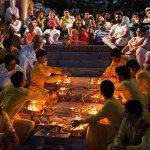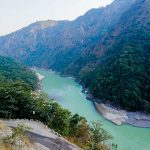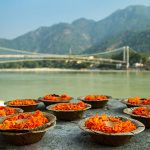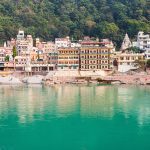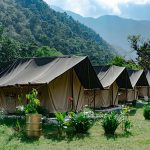The holy town of Rishikesh is known for its numerous temples and vibrant Ganga aarti.
Uttarakhand
The holy town of Rishikesh is known for its numerous temples and vibrant Ganga aarti. It is also for those who crave adrenaline and spirituality. Anushka Patodia visits this tiny town that has now made it to the global wellness landscape.
“13, 12, 11, 10…” I can feel people behind me exhale loudly and sigh as I will myself to hold on. My left leg is on the ground but the right is in my hand and behind my back as I’m bending forwards trying to balance my body on one leg. Around me is a bucolic landscape, something right out of a fairy tale, with lush fields to my right, the soft murmur of the Ganges flowing to my left and Himalayan peaks forming a protective barrier on all sides. “9, 8, 7, 6…” The sky is all shades of orange and blue and I can see the sun peeking out of the clouds to make its way to the top of the cerulean-carpeted sky.
It’s 5am (yes, 5 – I can hardly believe I’m up at this hour) and I’m willing my yoga instructor to count down faster so I can come back to standing position and look around me at the breath-taking scene in peace. “3, 2, 1…” It feels like an eternity has passed between these last three numbers as my foot finally rests on the ground and I exhale loudly and audibly. I have barely rested my right foot when it’s time to put the left one up and perform the asana again. But even amid the yoga pose I perform with difficulty, I have never felt more serene and at ease. I can actually feel my stress melt away and turn inconsequential as I stare at the mighty Himalayas all around me. Perhaps this is why Hindu sages and priests have thronged to Rishikesh for centuries in search of inner peace.
I’m on a terrace at the Parmarth Niketan ashram, one of the most popular ones in town, for an early morning yoga session. Built in the 1940s, Parmarth Niketan is also the host of the International Yoga Festival (which takes place in February/March) this year. I look around me at my fellow yoga practitioners and see a mixed bag of people. There’s something about yoga that unites people of all castes, creeds, religions and nationalities. It is also here that the Ganga Aarti takes place in the evenings, but we’ll come to that bit later. Known as the yoga capital of the world, Rishikesh is a haven for those seeking spirituality, meditation and inner peace. You’ll find all schools of yoga here, from hatha and iyengar to kundalini as well as lecturers on Vedanta philosophy. It’s no wonder then that yoga enthusiasts from across the globe flock to this tiny town in the Garhwal hills of Uttarakhand to learn from the best.
But yoga isn’t the only thing that has put Rishikesh on the global map. It was way back in 1968 that the Beatles — Paul McCartney, Ringo Starr, John Lennon and George Harrison – came to this temple town to attend a transcendental meditation session with Maharishi Mahesh Yogi. They later claimed that this experience greatly inspired them creatively and led to them having composed 20 songs. Ever since then, Rishikesh has become a place of visit for music lovers, hippies, yogis and those seeking spiritual awakening.
As for me, this was my second trip to the town and I was amazed to see the change that had taken place over the last seven years. Getting off at Dehradun’s Jolly Grant Airport, I was unsurprised to see saffron-clad sadhus and long-haired mendicants around me. What was pleasantly surprising, however, was the sheer number of adventure enthusiasts I encountered during my 20-odd kilometre drive to Rishikesh. The last time I’d been here, my experience had been largely religious and meditative — this time, however, I saw adventurers white-water rafting, kayaking, cycling, trekking and even bungee jumping all around me.
Over the last five to six years, the adventure tourism scene has exploded in this town, with many companies offering camping and adventure sports packages. Excited and filled with adrenaline at this proposition, I had signed myself up with Aquaterra Adventures for a three-day camp that included white-water rafting, abseiling and kayaking. The strong currents on the Ganges makes it ideal for rafting up to grade six. However, the beginner that I was, I decided to start with grade one.
Our camp, known as Silver Sands, was set up about 27 kilometres from Rishikesh, along the Rishikesh Devprayag Road, on a sandy river beach. The adventure sports season is from September to May, and the weather in March when I visited was calm and pleasant. Camp games, solitude, campfire tales, kayaking, abseiling, good food and newfound friends were promised to us before the trip. My first day was relaxed, with friendly introductions made with fellow campers. The rafting would take place the next day and I just could not wait.
After breakfast the next morning, we set off on our adventure pursuit. We were to raft the 22 kilometres to the Laxman Jhula, one of the largest and most popular suspension bridges in Rishikesh. I got on to my raft even as the staff gave instructions on how to manoeuvre it in the rapids. The rowing was strenuous but the sight of the rippling waters of the majestic Ganges around us made it all worth it. As morning turned into afternoon, I finally saw the silhouette of the Laxman Jhula up ahead even as my body swelled in pride (and relief) at having completed the tiring but exhilarating ride. Here, amid the waters of the Ganges and surrounded by the Himalayas I had ticked one more thing off my bucket list.
That day, after we returned to camp, and a few rounds of kayaking and abseiling later, I looked up at the sky and started to retire into my tent a happy girl. But nothing could have prepared me for the sheer beauty of the clear night sky, with thousands of stars glittering in its midst. I stared mesmerised for many minutes, in utter awe. I had gone stargazing in many places around India and the world, but this experience, surrounded by the camps with a bonfire on the beach, was truly unparalleled.
Aquaterra also co-runs Atali Ganga, an “activotel”, is a hotel with a specific focus on outdoor activities. After checking out of the camp, I decided to spend a day there to get some much-needed R&R as well as go birding and hiking. The eco-conscious hotel has individual cottages and conducts much of the same adventure activities as the camp, albeit in more luxurious surroundings. Another luxury camping property is AquaForest, which offers guests riverside luxury tents and is close to the white-water rafting sites.
Rishikesh has its fair share of luxury spa and yoga resorts, the most popular unarguably being Ananda – In The Himalayas. Having stayed there before and partaking in its daily yoga and exercise schedule, I knew that it offered one of the finest stays in Rishikesh. However, its 30-minute driving distance from the city made it impractical for me to explore the town. For this reason, Raga On The Ganges, one of the many boutique wellness retreats springing up within the city made for a better stay.
After my taste of adventure sports and yoga, I decided to explore the cultural side of Rishikesh. Walking around the crowded town threw up a number of scenes – devotees walking around with flowers and other offerings to the many temples before they began their Char Dham yatra, or pilgrimage; tourists taking pictures on the Laxman Jhula, which was built in 1823 and later rebuilt in 1930 after a great flood; mendicants walking around begging for alms; sadhus in saffron robes hurrying off to pray; the busy market with shopkeepers selling incense, Shiva statues, clothes, Beatles paraphernalia and yoga mats; cafes serving delicious organic, vegetarian food. (Rishikesh is a meat- and alcohol-free town.) I walked up to where the giant Shiva statue had once stood, which had been washed away in the floods three years ago. Everywhere I went, I could see hordes of tourists around me (statistics suggest that Uttarakhand attracts 20 million tourists a year). In the evening, I returned to Parmarth Niketan to attend the famous Ganga Aarti on the banks of the Ganges. The sheer spectacle, sounds, bells clanging, chanting, and number of attendees left me spellbound and more than a little shaken.
On the last leg of my holiday, I decided to venture out of the city to Rajaji National Park. Spread over 820 square kilometres, it is known for its wildlife, including elephants, mountain goats, deer, sloth bears, tigers, leopards and hyenas. Also part of Rajaji National Park was the ashram of Maharishi Mahesh Yogi, where the Beatles stayed. Now also called the Beatles ashram, the estate was in shambles. However, within the crumbling nooks and crannies, meditation pods and yoga pavilions, were whispers of the rich history buried here. As I walked around the estate, my guide told me about a music player and instructor called Mukesh, who conducted workshops in a hut. Mukesh had learned to play the Australian didgeridoo from a visiting tourist and now taught it to students under the name of Jungle Vibes. It is perhaps this rich history and talent that makes Rishikesh a place worthy of visit from tourists around the world.
In the quiet sanctity of its ashrams and yoga schools, in the adrenaline-pumping adventure sports now a ubiquitous part of the city, in its loud and cacophonous Ganga Aarti, in its secluded meditation centres, in its relaxing spa retreats and, above all, in its rich heritage, I found the inner peace that I had been searching for. As I made my way back to my flight which would transport me to the city I came from, I knew that I had come back richer and wiser from this holy town.
Subscribe to the latest edition now by clicking here.
If you would like to comment on this story or anything else you have seen on World Travel Magazine, head over to our Facebook page or message us on Twitter.
And if you liked this story, subscribe to our bi-monthly World Travel Magazine, a handpicked selection of editorial features and stories from Global Destinations, Inspire Me, Insider, Style File, Wellness & Travel, City Travel, Suite Life, At Leisure, Short Breaks and much more.


